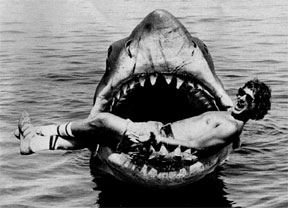
Another way that Nickelodeon created brand image was through animation. By the late 1980s, animation dominated children’s programming on the major broadcast networks. Through limited animation, produced by such studios as Filmation Associates and Hanna-Barbera Productions, networks found they could create shows based around pre-sold concepts that would appeal to advertisers. Programs like Teenage Mutant Ninja Turtles, Garfield, Fat Albert & The Cosby Kids, G.I. Joe, and My Little Pony worked off of previously conceived properties, such as books, toys, or movies, that were instantly recognizable to children and sold as product tie-ins. In some cases, these shows were merely half-hour commercials for the products they featured. Limited animation was economically sound enough to produce sufficient quantity to fill a four-hour time slot, as compared to live-action programming, and such cartoon blocks became quite profitable (Simensky 87-9).

However, these cartoons also received a lot of critical backlash, both from parents and the production community. They were clearly gender divided (He-Man for boys, Care Bears for girls, etc.), promoted little in terms of racial diversity or education, and were typified by violence. Likewise, characters and storylines were shaped by the demands of merchandise licensing. Lobby groups like Action for Children's Television appeared in the late 1960s to voice their concerns about the presentation of violence, anti-social attitudes and stereotypes in Saturday morning cartoons. By the 1970s, TV networks felt compelled to lay down strict content rules for animated programs. Critics and animators have complained that this proceeded to the point where the very basic elements of drama and suspense were severely restricted and artists were left with few avenues of expression. Even more disconcerting was that the prohibition against the depiction of anti-social elements often prompted conformist stories, such as in the Smurfs series, where almost any individual initiative often resulted in trouble for the group and therefore had to be avoided. Aside from the award-winning Muppet Babies program, Saturday morning cartoons continued its legacy as a haven of insipid sitcom rip-offs and hapless reruns (Sandler 46-7).

In order to maintain its kid-parent friendly, non-violent image, Nickelodeon took to creating its own original animated programs, called “Nicktoons”, in 1991. This was revolutionary for several reasons. For one, animation was a costly process and it was rare that a network would produce shows with original characters. “The decision to have original characters made perfect sense in that it would allow Nickelodeon to differentiate itself from the broadcast networks” says Linda Simensky in her essay The Early Days of Nickelodeon (93). “For the most part, the broadcast establishment had little interest in original characters, instead opting to play it safe with easily recognizable marquee characters” (Simensky 93). Also, cartoonists were given creative control, rather than writers and marketing teams, as cartoons had previously always been pre-sold with licensed products in mind. Network shows rarely kept the creator attached to a series for very long because it tended to make the production process slower and harder to manage, but Nickelodeon wanted creator-driven cartoons; they “believed that the best characters all lived inside the heart of their creators” (Simensky 92). By creating it’s own group of characters and allowing cartoonists to do their own work, Nickelodeon could create its own animated identity, as well as its own backlog of programs which could be aired at any time, justifying the production costs. Ultimately, these cartoons were a huge success and have since become the networks staple programming. The creator driven cartoon process has since been copied by almost every major kids network, including Cartoon Network, the Disney Channel, Fox Kids, and Kids WB.

Since its inception in 1979, Nickelodeon has not only become the number one children’s channel, but a household name. The network produces movies, magazines, toys, and all sorts of other licensed products. However, what separates it from previous forms of children’s television is its commitment to quality – putting kids first. Both parents and kids know that Nickelodeon is a fun, safe place to be a kid, and this image extends to every product Nick creates. In such a way, the network is a great example of the way corporate branding functions on cable television. Likewise, Nickelodeon’s radical new forms of approaching children’s programming have had a lasting effect on the children’s entertainment industry, influencing everything from show design to production to basic philosophies. In short, Nickelodeon was the best thing that could have happened to TV for kids.
Check out the whole article!
Sources:
Gore, Chris. "Cel Out- The Plot to Kill Cartoons”. Wild Cartoon Kingdom #1, 1993
Hendershot, Heather. “Nickelodeon & The Business of Fun”. Nickelodeon Nation. Ed. Heather Hendershot. New York: NYU Press, 2004. 1 – 14.
Hutsul, Christopher. “Ren and Stimpy creator tries an online end-run to get back in the game”. Toronto Star. 6 Apr 2006.
Langer, Mark. “Ren & Stimpy: Fan Culture and Corporate Strategy”. Nickelodeon Nation. Ed. Heather Hendershot. New York: NYU Press, 2004. 155 – 181.
Nakata, Hiroko. “Exporting animation a huge Japanese success story”. The Japan Times. 7 July 2004.
Pecora, Norma. “Nickelodeon Grows Up: The Economic Evolution of a Network”. Nickelodeon Nation. Ed. Heather Hendershot. New York: NYU Press, 2004. 15 –44.
Sandler, Kevin S. “A Kid’s Gotta Do What A Kid’s Gotta Do: Branding the Nickelodeon Experience”. Nickelodeon Nation. Ed. Heather Hendershot. New York: NYU Press, 2004. 45 – 65.
Seiter, Ellen and Vicki Mayer. “Diversifying Representation in Children’s TV: Nickelodeon’s Model”. Nickelodeon Nation. Ed. Heather Hendershot. New York: NYU Press, 2004. 120 – 134.
Simensky, Linda. “The Early Days of Nickelodeon”. Nickelodeon Nation. Ed. Heather Hendershot. New York: NYU Press, 2004. 87 – 107.
Stuart, Audrey. “Animation remains all-powerful in kids TV”. Agence France Presse. 18 Oct 2005.
Stuart, Audrey. “Comedy creeps back into kids TV”. Agence France Presse. 6 Oct 2005












